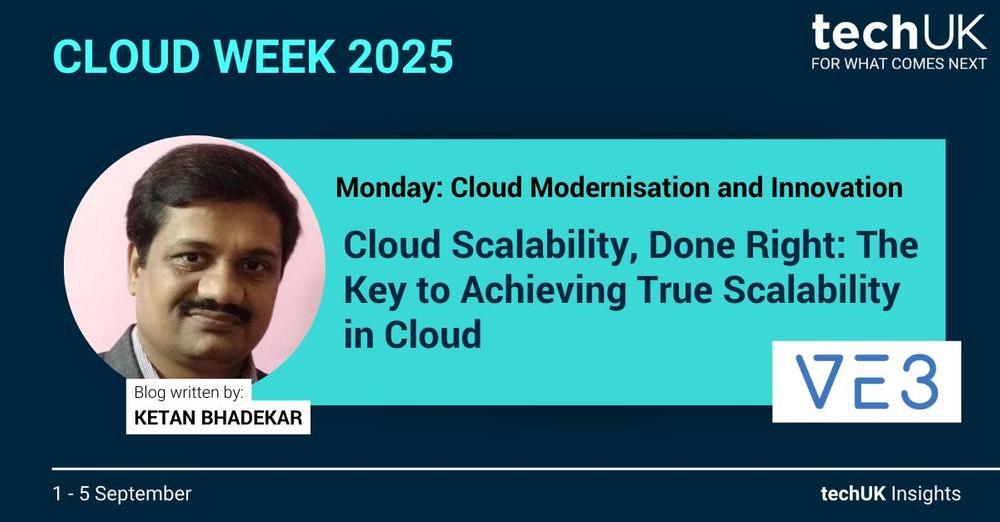Cloud Scalability, Done Right: The Key to Achieving True Scalability in Cloud (Guest blog from VE3)

This blog was written by Ketan Bhadekar, Director of Technology & Platforms, VE3
In this digital-first AI era, dynamically scaling the IT services and infrastructure has become a significant aspect.
We work with enterprises across industries that face not just the technical challenge of scaling cloud services, but the strategic one — how to make cloud elasticity align with business growth, cost governance, and regulatory frameworks.
Scaling infrastructure quickly and efficiently is now a cornerstone of modern business success. Whether enterprises need to handle unexpected traffic spikes, accommodate global user bases, or rapidly launch new services, scalability is no longer optional — it is essential.
Cloud computing promises virtually limitless scalability, but at VE3 we believe that true scalability requires more than a lift-and-shift to the public cloud. With the right architecture, strategic decision-making, operational maturity, continuous optimization, and an intelligent technology stack, enterprises can unlock sustainable scalability.
This article is a walkthrough of VE3’s perspective on scalable cloud infrastructure, why scalability matters in the long run, and the key pillars of VE3’s approach to achieving it.
Understanding Cloud Scalability
Cloud scalability is the ability of a cloud computing system to handle increasing or decreasing workloads by dynamically adjusting computing resources. What makes scalability powerful is its promise of agility without compromising performance, availability, or cost.
At VE3, we see scalability as more than resource expansion — it is about building elastic, cost-aware, and governance-ready systems that can evolve as business needs change.
According to the Precedence Research report, the cloud computing market reached a value of USD 753.11 billion in 2024 and is anticipated to reach around USD 5,150.92 billion by 2034. It will show an expanded CAGR of 21.20% from 2025 to 2034. This growth reflects exactly why enterprises cannot afford to treat scalability as an afterthought.
Since the cloud comes bundled with computing power, tools, storage, infrastructure services, and network capacity, it allows businesses to enjoy nearly unlimited resources with the pay-as-you-go model. Modern AI development needs high-end cloud GPUs for training large models using volumetric data. These data again reside in the cloud. With the power of scalability, enterprises can add more storage compartments or GPU instances for high-performance computing (HPC). A highly scalable cloud infrastructure should provide features such as high performance on demand, high availability, more agility as per business needs, and massive storage.
Scalability Gaps We See in the Market
- Siloed Cloud Adoption – Companies adopt cloud tools (IaC, load balancing, microservices) but treat them in isolation, leading to fragmentation.
- Scalability Without Governance – Teams scale workloads fast but overlook compliance, cost visibility, or data residency, which eventually stalls growth.
- Reactive vs. Proactive Scaling – Scaling decisions often happen under pressure (traffic surge, app crash) instead of being designed into the system.
- Elasticity ≠ Resilience – Many assume elasticity equals resilience, but without fault-tolerance, redundancy, and cost-awareness, elasticity alone fails.
- Over-Investing Without Outcomes – Organizations spend on autoscaling and container orchestration but don’t link it back to business growth or ROI.
The Future of Business-Centric Auto-Scaling
Looking ahead, the future of scalability will move beyond infrastructure metrics into business-aware, compliance-aware, and even sustainability-aware models. Imagine systems that auto-scale in anticipation of a product launch or dynamically shift workloads to greener data centers to meet ESG commitments. At VE3, we are already helping clients prepare for this shift — embedding business signals directly into their scalability strategies.
The VE3 Cloud Scalability Framework
To move beyond textbook definitions, VE3 frames scalability through five practical pillars that guide our work with clients:
- Elastic by Design. Build cloud-native architecture with microservices, containers, and stateless design so each component scales independently.
- Automated by Default. Use Infrastructure as Code (Terraform, Pulumi, CloudFormation) and policy-driven scaling to ensure repeatable, version-controlled, and cost-efficient elasticity.
- Data-Centric Scaling. Architect scalable data lakes, apply sharding/partitioning, and leverage predictive data pipelines to ensure storage and analytics scale with demand.
- Global Reach, Local Compliance. Deploy across regions, leverage geo-distributed databases and CDNs, and integrate governance/security controls into scaling architectures.
- AI-Powered Forecasting. Apply ML models to predict demand spikes, optimize thresholds, and enable proactive scaling instead of reactive responses.
Moving from Technical Scaling to Business-Centric Scaling
Most enterprises stop at CPU- or memory-based auto-scaling. At VE3, we extend scaling triggers beyond infrastructure metrics to include business events, compliance thresholds, and even sustainability goals. This turns scaling into a strategic capability — not just an engineering response.
With the high demand for real-time scalability in computation and storage due to heavy workload, enterprises want cloud services that can dynamically scale. Therefore, CSPs should design thoughtful architecture, automation processes, resource management, and continuous monitoring with optimization. Let us explore the step-by-step guide to achieve true cloud scalability.
Design cloud-native architecture:
To achieve true scalability, cloud service providers should design cloud services with a cloud-native architecture. It will comprise elasticity, resilience, automation, and distributed processing. To achieve cloud-native architecture, we need to break monolithic applications into independent and loosely coupled services by leveraging microservices. Each microservice can scale independently on demand. We can also design cloud applications through "containers" (using Docker) to make them lightweight and portable.
Use Infrastructure as Code (IaC) for Automation:
Infrastructure as Code (IaC) tools such as AWS CloudFormation, Pulumi, or Terraform provide repeatable, version-controlled, and automated provisioning of infrastructure. By defining infrastructure in code (using declarative or imperative scripts), organizations can achieve true cloud scalability, ensuring consistency, rapid provisioning, and cost-efficiency. IaC tools also offer automated and on-demand provisioning, enabling elastic scaling because enterprises can deploy resources instantly. Lastly, infrastructure codes remain stored in Git (or other VCs) - enabling collaboration, rollbacks, and change tracking.
Load balancing and Policy Scaling:
Various cloud-native features, such as Amazon EC2 Auto Scaling, Azure Virtual Machine Scale Sets, and Google Cloud Instance Groups, enable cloud engineers and users to respond to metrics like CPU usage, memory utilization, or request rates. Load balancers (e.g., AWS ELB, Azure Load Balancer, NGINX) distribute traffic across instances, ensuring efficient resource utilization. By enabling load balancing and auto-scaling into the picture, enterprises can achieve true scaling power with cloud technology for compute-intensive workloads.
Stateless Application Design with Scalable Storage
For achieving scalability, especially horizontal scalability, applications must be stateless. It means they do not store session data on the server. The entire architecture works as a distributed cache (using Redis, Memcached, etc.). Again, scalability requires applications' data storage and databases to grow with demand. That is where object storage (Amazon S3), Scalable NoSQL, data lakes, and data warehouses help. From scalable data analytics to semi-structured and unstructured data storage, stateless applications with scalable storage have it all.
Global Scalability of Cloud
To serve global users, applications must scale across regions:
- Multi-Region Deployments: Deploying across multiple regions globally enhances redundancy, reduces latency, reduces risk, and helps enterprises meet regulatory formalities.
- Geo-Distributed Databases: We can also leverage databases like Cosmos DB or Spanner that offer multi-region consistency. They allow real-time data access from anywhere, making cloud data access scalable.
- Content Delivery Networks (CDNs): CDNs can enable cache content near the user to help enterprises improve performance. Akamai, Cloudflare, AWS CloudFront, etc., are some well-known CDNs.
- Anycast DNS & Global Load Balancing: We can direct users to the nearest instance using latency-based or geo-based routing. It also helps eliminate latency, increase throughput, and make cloud services scalable across the globe.
Industry-Specific Scalability in Action
Scalability challenges differ across industries, and VE3 tailors cloud designs accordingly:
- Healthcare: Scaling secure data lakes for sensitive patient records while ensuring HIPAA/GDPR compliance.
- Retail: Auto-scaling for seasonal shopping peaks and AI-driven demand forecasting.
- Financial Services: Latency-sensitive workloads like real-time trading or fraud detection that require both scale and ultra-low response times.
This industry-first approach ensures scalability supports not just technological growth but business outcomes.
Best Practices We Recommend
- Planning for data partitioning. Sharding data can help reduce the load on individual database nodes. Each partition handles a subset of data, improving read/write throughput.
- Constantly optimize and evaluate system performance, refactor inefficient code, upgrade services, and align scaling strategies with usage patterns. It helps keep cloud services and scalability responsive and agile.
- Cloud resource monitoring. It helps implement cost governance through right-sized instances. Monitoring and budgeting costs during scaling with tools like AWS Cost Explorer or Azure Cost Management can help enterprises stay within the budget while enjoying true scalability.
- The use of AI algorithms can help create an intelligent framework to scale. They can predict demand spikes, identify and optimize scaling factors, and make smart threshold-based auto-scaling.
- Continuous Integration and Delivery (CI/CD). It helps ensure consistent, frequent, and reliable deployments while eliminating human errors. Automated pipelines can streamline easy updates and scaling changes on demand.
VE3’s Vision for Scalable Cloud
With the right combination of design patterns, cloud-native technologies, and operational efficacy, enterprises can scale intelligently and sustainably, turning their cloud infrastructure into a true enabler of business growth and innovation.
At VE3, we believe that true scalability is the difference between surviving and thriving in the AI-driven enterprise era. With the right combination of design patterns, intelligent automation, and data-driven governance, enterprises can scale sustainably, globally, and intelligently.
Cloud scalability is not just about adding resources — it is about ensuring elasticity supports business growth, cost efficiency, and compliance in equal measure.
In the race to serve global audiences and process ever-growing volumes of data, we can achieve true scalability, building a competitive edge. With the right combination of design patterns, cloud-native technologies, and operational efficacy, enterprises can scale intelligently and sustainably, turning their cloud infrastructure into a true enabler of business growth and innovation. In this journey of making cloud a true scalable beast, enterprises are also using AI/ML algorithms to train systems to recognize scaling needs and predict workforce requirements.
Scalability of the future will be predictive, sustainable, and business-aligned. At VE3, we don’t see scalability as a checkbox of cloud engineering, but as an intelligent growth enabler that connects elasticity to business calendars, compliance mandates, and sustainability goals. This is the next era of true scalability — and the benchmark we help our clients achieve.
For more information please contact:





